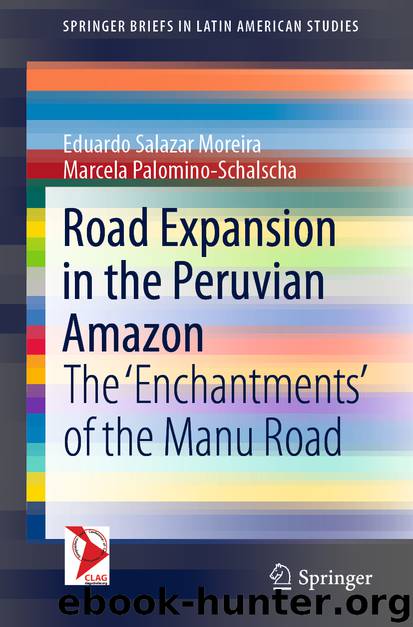Road Expansion in the Peruvian Amazon by Eduardo Salazar Moreira & Marcela Palomino-Schalscha

Author:Eduardo Salazar Moreira & Marcela Palomino-Schalscha
Language: eng
Format: epub
ISBN: 9783030471828
Publisher: Springer International Publishing
5.2.2 A Dead Stop—The Results of Road Connectivity
Despite the aspirations held in off-road communities, what Eduardo saw in on-road communities was only a slight improvement. As in many other cases, the fulfilment of what the road promised was illusory (Harvey and Knox 2012; Kernaghan 2012; Wilson 2004). One of the elements of the gap between the aspirations held by off-road communities and the realizations of on-road communities is the lack of surface quality and required maintenance of the Manu Road. As in other cases, its material state significantly curtails the expected effects of its construction (Harvey and Knox 2012; Kernaghan 2012; Pieck 2011). Its fragility, its vulnerability to how it is used and to the environmental conditions affecting it, clearly interrupted the smooth flow of goods and people (Harvey et al. 2017). These effects are common throughout Peru, especially in the Amazonian regions (Barrantes et al. 2014; Larsen 2016).
This is noticeable in Eduardo’s experience and that of Mr. Cabello’s other bus passengers, described in Sect. 5.1.2. His passengers worry strongly about the lack of maintenance, also mentioned in studies about this road (Larrea-Gallegos et al. 2016), which prevents it from delivering the speed expected by off-road communities and even generates new risks, like vehicular accidents. Another one of Eduardo’s experiences on the road was a clear example of this. He says:While waiting in Puerto Shipetiari to travel back to Salvación, I suddenly noticed that no cars or trailers were coming or going. One of the shop owners was talking loudly at her radio. Apparently, a large section of the road on a steep mountainside had collapsed under a trailer and the vehicle was stuck, blocking the way through for other vehicles (see Fig. 5.1). All traffic up and down the road was stopped and the machines that could fix the road could only get there the next day. After the news was announced, several men drove away swiftly on their motorcycles. They would help unload the trailers that were stuck so their cargo could be reloaded onto trailers at the other side of the obstruction. Those of us at the port would have to wait for transports that could take us to the relay point or walk to it. It seemed that frustratingly long and uncertain waits were not only part of river travel, but often remained with the construction of the road. Thus, the fragility of the road perpetuated the risks, uncertainty and delays that characterized river travel. Other travellers and I were able to make our way back to the relay point thanks to a SERNANP pickup truck that had brought Park officials to the port after doing the relay themselves. We had to walk past the landslide and wait for a trailer to drive us back to Salvación on the other side. We would arrive there late in the afternoon. The lack of speed I experienced on the road was similar to the one I went through when travelling by river.
Fig. 5.1The road to Shipetiari collapses under
Download
This site does not store any files on its server. We only index and link to content provided by other sites. Please contact the content providers to delete copyright contents if any and email us, we'll remove relevant links or contents immediately.
International Integration of the Brazilian Economy by Elias C. Grivoyannis(86549)
The Radium Girls by Kate Moore(11870)
Turbulence by E. J. Noyes(7898)
Nudge - Improving Decisions about Health, Wealth, and Happiness by Thaler Sunstein(7465)
The Black Swan by Nassim Nicholas Taleb(6950)
Rich Dad Poor Dad by Robert T. Kiyosaki(6321)
Pioneering Portfolio Management by David F. Swensen(6172)
Man-made Catastrophes and Risk Information Concealment by Dmitry Chernov & Didier Sornette(5880)
Zero to One by Peter Thiel(5640)
Secrecy World by Jake Bernstein(4596)
Millionaire: The Philanderer, Gambler, and Duelist Who Invented Modern Finance by Janet Gleeson(4303)
Skin in the Game by Nassim Nicholas Taleb(4125)
The Age of Surveillance Capitalism by Shoshana Zuboff(4120)
The Money Culture by Michael Lewis(4029)
Bullshit Jobs by David Graeber(3997)
Skin in the Game: Hidden Asymmetries in Daily Life by Nassim Nicholas Taleb(3870)
The Dhandho Investor by Mohnish Pabrai(3639)
The Wisdom of Finance by Mihir Desai(3609)
Blockchain Basics by Daniel Drescher(3432)
